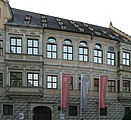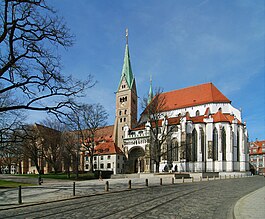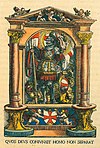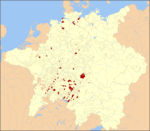world.wikisort.org - Germany
Augsburg (German: [ˈaʊksbʊʁk] (![]() listen); Swabian German: Augschburg, UK: /ˈaʊɡzbɜːrɡ/ OWGZ-burg,[3] US: /ˈɔːɡz-/ AWGZ-[4]) is a city in Swabia, Bavaria, Germany, around 50 kilometres (31 mi) west of Bavarian capital Munich. It is a university town and regional seat of the Regierungsbezirk Schwaben with an impressive Altstadt (historical city centre). Augsburg is an urban district and home to the institutions of the Landkreis Augsburg. It is the third-largest city in Bavaria (after Munich and Nuremberg) with a population of 300,000 inhabitants, with 885,000 in its metropolitan area.[5]
listen); Swabian German: Augschburg, UK: /ˈaʊɡzbɜːrɡ/ OWGZ-burg,[3] US: /ˈɔːɡz-/ AWGZ-[4]) is a city in Swabia, Bavaria, Germany, around 50 kilometres (31 mi) west of Bavarian capital Munich. It is a university town and regional seat of the Regierungsbezirk Schwaben with an impressive Altstadt (historical city centre). Augsburg is an urban district and home to the institutions of the Landkreis Augsburg. It is the third-largest city in Bavaria (after Munich and Nuremberg) with a population of 300,000 inhabitants, with 885,000 in its metropolitan area.[5]
Augsburg | |
|---|---|
City | |
|
From top: Perlachturm (left) and Augsburg Town Hall (right), Maximilian Museum, Fuggerei and Augsburg Cathedral. | |
 Flag  Coat of arms | |
Location of Augsburg  | |
 Augsburg  Augsburg | |
| Coordinates: 48°22′08″N 10°53′52″E | |
| Country | Germany |
| State | Bavaria |
| Admin. region | Swabia |
| District | Urban district |
| Government | |
| • Lord mayor (2020–26) | Eva Weber[1] (CSU) |
| Area | |
| • City | 146.84 km2 (56.70 sq mi) |
| Elevation | 494 m (1,621 ft) |
| Population (2020-12-31)[2] | |
| • City | 295,830 |
| • Density | 2,000/km2 (5,200/sq mi) |
| • Metro | 885,000 |
| Time zone | UTC+01:00 (CET) |
| • Summer (DST) | UTC+02:00 (CEST) |
| Postal codes | 86150–86199 |
| Dialling codes | 0821 |
| Vehicle registration | A |
| Website | www |
After Neuss, Trier, Cologne and Xanten, Augsburg is one of Germany's oldest cities, founded in 15 BC by the Romans as Augusta Vindelicorum, named after the Roman emperor Augustus. It was a Free Imperial City from 1276 to 1803 and the home of the patrician Fugger and Welser families that dominated European banking in the 16th century. According to Behringer, in the sixteenth century, it became "the dominant centre of early capitalism", having benefitted from being part of the Kaiserliche Reichspost system as "the location of the most important post office within the Holy Roman Empire" and the city's close connection to Maximilian I.[6] The city played a leading role in the Reformation as the site of the 1530 Augsburg Confession and 1555 Peace of Augsburg. The Fuggerei, the oldest social housing complex in the world, was founded in 1513 by Jakob Fugger.
In 2019, UNESCO recognized the Water Management System of Augsburg as a World Heritage Site because of its unique medieval canals and water towers and its testimony to the development of hydraulic engineering.[7][8]
Geography
Augsburg lies at the convergence of the Alpine rivers Lech and Wertach and on the Singold. The oldest part of the city and the southern quarters are on the northern foothills of a high terrace, which has emerged between the steep rim of the hills of Friedberg in the east and the high hills of the west. In the south extends the Lechfeld, an outwash plain of the post ice age between the rivers Lech and Wertach, where rare primeval landscapes were preserved. The Augsburg city forest and the Lech valley heaths today rank among the most species-rich middle European habitats.[9]
Augsburg borders on the nature park Augsburg Western Woods - a large forestland. The city itself is also heavily verdant. As a result, in 1997 Augsburg was the first German city to win the Europe-wide contest Entente Florale for Europe's greenest and most livable city.
Suburbs and neighbouring municipalities
Augsburg is surrounded by the counties Landkreis Augsburg in the west and Aichach-Friedberg in the east.
The suburbs of Augsburg are Friedberg, Königsbrunn, Stadtbergen, Neusäß, Gersthofen, Diedorf.
Neighbouring municipalities: Rehling, Affing, Kissing, Mering, Merching, Bobingen, Gessertshausen.
History
This section needs additional citations for verification. (March 2011) |

Early history

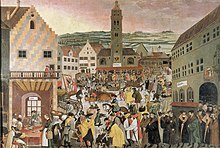
The city of Augsburg was founded in 15 BC on the orders of Emperor Augustus.[10] Emperor Augustus conducted extensive military campaigns and established administrative settlements. The settlement that became Augsburg was known as Augusta Vindelicorum, meaning "the Augustan city of the Vindelici".[11] The settlement was established at the convergence of the Alpine rivers Lech and Wertach. In 120 AD Augsburg became the administrative capital of the Roman province Raetia.[12] Augsburg was sacked by the Huns in the 5th century AD, by Charlemagne in the 8th century, and by Welf I, Duke of Bavaria in the 11th century.[citation needed]
Augsburg Confession
Mixed Imperial City of Augsburg Paritätische Reichsstadt Augsburg | |||||||||
|---|---|---|---|---|---|---|---|---|---|
| 1276–1803 (Occupied by Sweden 1632–35) | |||||||||
 Coat of arms of Augsburg before 1985
| |||||||||
| Status | Mixed Imperial City (State of the Holy Roman Empire) | ||||||||
| Capital | Augsburg | ||||||||
| Government | Republic | ||||||||
| Historical era | Middle Ages | ||||||||
• Bishopric established | 4th century | ||||||||
• Bishopric gained Imperial immediacy | c. 888 | ||||||||
• City gained immediacy | 1276 | ||||||||
• Diet of Augsburg: Confessio Augustana | 1530 | ||||||||
• Joined Schmalkadic League | 1537 | ||||||||
• Peace of Augsburg | 1555 | ||||||||
• Occupied by Sweden | 1632–35 | ||||||||
• Mediatised to Bavaria | 1803 | ||||||||
| |||||||||
Augsburg was granted the status of a Free Imperial City on 9 March 1276 and from then until 1803, it was independent of its former overlord, the Prince-Bishop of Augsburg. Frictions between the city-state and the prince-bishops were to remain frequent however, particularly after Augsburg became Protestant and curtailed the rights and freedoms of Catholics. With its strategic location at an intersection of trade routes to Italy, the Free Imperial City of Augsburg became a major trading center.[citation needed]
Augsburg produced large quantities of woven goods, cloth and textiles. Augsburg became the base of two banking families that rose to great prominence, the Fuggers and the Welsers. The Fugger family donated the Fuggerei part of the city devoted to housing for needy citizens in 1516, which remains in use today.[13]
In 1530, the Augsburg Confession was presented to the Holy Roman Emperor at the Diet of Augsburg. Following the Peace of Augsburg in 1555, after which the rights of religious minorities in imperial cities were to be legally protected, a mixed Catholic–Protestant city council presided over a majority Protestant population; see Paritätische Reichsstadt.[citation needed]
Leading European centre of capitalism of the sixteenth century

Augsburg's economic boom years occurred during the 15th and 16th centuries thanks to the bank and metal businesses of the merchant families Fugger, Welser and Hochstetter. These families held a near total monopoly in important industries. Monopolies were considered criminal in contemporary laws and these families' practices were criticized by Martin Luther himself, but as Emperor Charles V needed their financial assistance, he cancelled the charged in the 1530s.[14][15] In the 16th century Augsburg became one of Germany's largest cities. Augsburg was a major manufacturing center for textiles, armor, scientific instruments, as well as gold- and silver-smithing. The prolific printers of Augsburg also made the city the largest producer of German-language books in the Holy Roman Empire. Like other free imperial cities, Augsburg was an independent entity, and had authority over its tax policies.[16]
Augsburg's wealth attracted artists seeking patrons. The city rapidly became a creative centre for sculptors and musicians. Augsburg became the base of the Holbein family, starting with Hans Holbein the Elder. The composer Leopold Mozart was born and educated in Augsburg.[17] Rococo became so prevalent that it became known as "Augsburg style" throughout Germany.[citation needed]
Augsburg benefitted majorly from the establishment and expansion of the Kaiserliche Reichspost in the late 15th and early 16th century. This postal system, which was the first modern postal service in the world, was created through negotiations and agreements between the Taxis family represented by Franz von Taxis and the early Habsburgs monarches, notably Maximilian I, his son Philip the Handsome and grandson Charles V.[18][19] Even when the Habsburg empire began to extend to other parts of Europe, Maximilian's loyalty to Augsburg, where he conducted a lot of his endeavours, meant that the imperial city became "the dominant centre of early capitalism" of the sixteenth century, and "the location of the most important post office within the Holy Roman Empire". From Maximilian's time, as the "terminuses of the first transcontinental post lines" began to shift from Innsbruck to Venice and from Brussels to Antwerpt, in these cities, the communication system and the news market started to converge. As the Fuggers as well as other trading companies based their most important branches in these cities, these traders gained access to these systems as well.(Despite a widely circulated theory which holds that the Fuggers themselves operated their own communication system, in reality they relied upon the imperial posts, presumably from the 1490s onwards, as official members of the court of Maximilian I).[20]
Witch hunts
Several witch hunts ocurred in Augsburg in the late 16th century. Following the 1585–1588 plague epidemic, southeast Germany was shattered by the 1589–1591 witch hunts. Following the 1592–1593 plague epidemic, cities in southeast Germany entered a period of inflation, marked by brutal witch hunts in urban areas.[21]
Thirty Years' War
Religious peace in the city was largely maintained despite increasing tensions up to the Thirty Years' War (1618–1648). In 1629, the Holy Roman Emperor Ferdinand II issued the Edict of Restitution, which restored the legal situation of 1552. However, the edict was revoked in April 1632, when Gustavus Adolphus of Sweden occupied Augsburg.[citation needed]
In 1634, the Swedish army was defeated at the nearby Battle of Nördlingen. By October 1634, Catholic troops had surrounded Augsburg. The Swedish army refused to surrender and a siege ensued through the winter of 1634/35 and thousands died from hunger and disease. During the Swedish occupation and the siege by Catholic troops, the population of the city was reduced from about 70,000 to about 16,000. Diseases such as typhus and the plague ravaged the city.[22]
Guilds
In the first half of the 17th century Augsburg was pivotal in the European network of goldsmiths. Augsburg attracted goldsmith journeymen from all over Europe and in the 18th century a large number of silversmiths and goldsmiths became master craftsman in Augsburg.[23]
Nine Years' War
In 1686 the Holy Roman Emperor Leopold I formed the League of Augsburg, also known as the "Grand Alliance" after England joined in 1689. The coalition consisted at various times of Austria, Bavaria, Brandenburg, England, the Holy Roman Empire, the Electorate of the Palatinate, Portugal, Savoy, Saxony, Spain, Sweden, and the Dutch Republic. The coalition was formed to defend the Electorate of the Palatinate and fought against France in the Nine Years' War.[citation needed]
End of Free Imperial City status


The Reichsdeputationshauptschluss or the Final Recess of 1803, saw the annexation of nearly all of the 51 Free Imperial Cities, excepting Augsburg and five others. However, when the Holy Roman Empire was dissolved in 1806, Napoleon encouraged his German allies to mediatize their smaller neighbours, and Augsburg lost its independence. It was annexed to the Kingdom of Bavaria. In 1817, the city became an administrative capital of the Oberdonaukreis, then administrative capital in 1837 for the district Swabia and Neuburg.[citation needed]
Industrial revolution
During the end of the 19th century, Augsburg's textile industry again rose to prominence followed by the machine manufacturing industry.[citation needed]
Second World War and Cold War
Augsburg was historically a militarily important city due to its strategic location. During the German re-armament before the Second World War, the Wehrmacht enlarged Augsburg's one original Kaserne (barracks) to three: Somme Kaserne (housing Wehrmacht Artillerie-Regiment 27); Arras Kaserne (housing Wehrmacht Infanterie Regiment 27) and Panzerjäger Kaserne (housing Panzerabwehr-Abteilung 27 (later Panzerjäger-Abteilung 27)). Wehrmacht Panzerjäger-Abteilung 27 was later moved to Füssen.
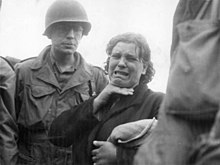
The MAN factory at Augsburg was the largest German manufacturer of engines for U-boats in World War II and became the target of the Augsburg Raid. When the Avro Lancaster bomber was new in service, the RAF sent 12 at low level to bomb the factory in daylight, on 17 April 1942. The bombers were intercepted en-route and only five returned, all damaged. The factory was damaged but production continued; the factory was repeatedly bombed later. A subcamp of the Dachau concentration camp outside Augsburg supplied approximately 1,300 forced labourers to local military-related industry, especially the Messerschmitt AG military aircraft firm, headquartered in Augsburg.[24][25]
In 1941, Rudolf Hess, without Adolf Hitler's permission, secretly took off from a local Augsburg airport and flew to Scotland, crashing in Eaglesham. His objective was to meet the Duke of Hamilton in an attempt to mediate the end of the European front of World War II and join sides for the upcoming Russian Campaign.
The Reichswehr Infanterie Regiment 19 was stationed in Augsburg and became the base unit for the Wehrmacht Infanterie Regiment 40, a subsection of the Wehrmacht Infanterie Division 27 (which later became the Wehrmacht Panzerdivision 17). Elements of Wehrmacht II Battalion of Gebirgs-Jäger-Regiment 99 (especially Wehrmacht Panzerjäger Kompanie 14) was composed of parts of the Wehrmacht Infanterie Division 27. The Infanterie Regiment 40 remained in Augsburg until the end of the war, finally surrendering to the United States when on 28 April 1945, the U.S. Army occupied the city. The city and its Messerschmitt works were bombed on three occasions during the war. Collateral damage included the destruction of just under 25% of all homes in the city and the deaths of several hundred people.[26]
Following the war, the three Kaserne would change hands confusingly between the American and Germans, finally ending up in US hands for the duration of the Cold War. They became the three main US barracks in Augsburg: Reese, Sheridan and FLAK. US Base FLAK had been an anti-aircraft barracks since 1936 and US Base Sheridan "united" the former infantry barracks with a smaller Kaserne for former Luftwaffe communications units.
The American military presence in the city started with the U.S. 5th Infantry Division stationed at FLAK Kaserne from 1945 to 1955, then by 11th Airborne Division, followed by the 24th Infantry Division, U.S. Army VII Corps artillery, USASA Field Station Augsburg and finally the 66th Military Intelligence Brigade, which returned the former Kaserne to German hands in 1998. Originally the Heeresverpflegungshauptamt Südbayern and an Officers' caisson existed on or near the location of Reese-Kaserne, but was demolished by the occupying Americans.
Politics
Municipality
From 1266 until 1548, the terms Stadtpfleger (head of town council) and Mayor were used interchangeably, or occasionally, simultaneously. In 1548 the title was finally fixed to Stadtpfleger, who officiated for several years and was then awarded the title for life (though no longer governing), thus resulting confusingly, in records of two or more simultaneous Stadtpfleger.
After the transfer to Bavaria in 1806, Augsburg was ruled by a Magistrate with two mayors, supported by an additional council of "Community Commissioners": the Gemeindebevollmächtige.
As of 1907, the Mayor was entitled Oberbürgermeister, as Augsburg had reached a population of 100,000, as per the Bavarian Gemeindeordnung.
Mayor
The current mayor of Augsburg is Eva Weber of the Christian Social Union (CSU) since 2020. The most recent mayoral election was held on 15 March 2020, with a runoff held on 29 March, and the results were as follows:
| Candidate | Party | First round | Second round | |||
|---|---|---|---|---|---|---|
| Votes | % | Votes | % | |||
| Eva Weber | Christian Social Union | 41,534 | 43.1 | 63,762 | 62.3 | |
| Dirk Wurm | Social Democratic Party | 18,116 | 18.8 | 38,532 | 37.7 | |
| Martina Wild | Alliance 90/The Greens | 17,851 | 18.5 | |||
| Andreas Jurca | Alternative for Germany | 4,673 | 4.8 | |||
| Peter Hummel | Free Voters of Bavaria | 3,053 | 3.2 | |||
| Frederik Hintermayr | The Left | 2,564 | 2.7 | |||
| Lisa McQueen | Die PARTEI | 1,896 | 2.0 | |||
| Bruno Marcon | Augsburg in the Citizens' Hands | 1,478 | 1.5 | |||
| Anna Tabak | We are Augsburg | 1,261 | 1.3 | |||
| Lars Vollmar | Free Democratic Party | 1,249 | 1.3 | |||
| Christian Pettinger | Ecological Democratic Party | 1,183 | 1.2 | |||
| Claudia Eberle | Pro Augsburg | 941 | 1.0 | |||
| Florian Betz | V-Partei³ | 678 | 0.7 | |||
| Valid votes | 96,477 | 99.4 | 102,294 | 99.4 | ||
| Invalid votes | 578 | 0.6 | 661 | 0.6 | ||
| Total | 97,055 | 100.0 | 102,955 | 100.0 | ||
| Electorate/voter turnout | 214,110 | 45.3 | 213,982 | 48.1 | ||
| Source: City of Augsburg (1st round, 2nd round) | ||||||
City council

The Augsburg city council governs the city alongside the Mayor. The most recent city council election was held on 15 March 2020, and the results were as follows:
| Party | Votes | % | +/- | Seats | +/- | |
|---|---|---|---|---|---|---|
| Christian Social Union (CSU) | 1,653,781 | 32.3 | 20 | |||
| Alliance 90/The Greens (Grüne) | 1,198,090 | 23.4 | 14 | |||
| Social Democratic Party (SPD) | 734,066 | 14.3 | 9 | |||
| Alternative for Germany (AfD) | 337,834 | 6.6 | 4 | ±0 | ||
| Free Voters of Bavaria (FW) | 230,952 | 4.5 | 3 | |||
| The Left (Die Linke) | 189,034 | 3.7 | 2 | ±0 | ||
| Free Democratic Party (FDP) | 117,201 | 2.3 | 1 | ±0 | ||
| Ecological Democratic Party (ÖDP) | 114,119 | 2.2 | 1 | ±0 | ||
| Generation AUX (GenAUX) | 108,956 | 2.1 | New | 1 | New | |
| Augsburg in the Citizens' Hands (AiB) | 96,690 | 1.9 | New | 1 | New | |
| Pro Augsburg (PRO A) | 94,346 | 1.8 | 1 | |||
| We are Augsburg (WSA) | 77,189 | 1.5 | New | 1 | New | |
| Die PARTEI | 76,557 | 1.5 | New | 1 | New | |
| V-Partei³ | 69,643 | 1.4 | New | 1 | New | |
| Political Voters' Association/Democracy in Motion (Polit-WG/DiB) | 29,149 | 0.6 | 0 | |||
| Total | 5,127,607 | 100.0 | ||||
| Invalid votes | 2,079 | 2.1 | ||||
| Total | 97,013 | 100.0 | 60 | ±0 | ||
| Electorate/voter turnout | 214,110 | 45.3 | ||||
| Source: City of Augsburg | ||||||
Members of the Bundestag
Augsburg is located in the Wahlkreis 253 Augsburg-Stadt constituency, which includes Königsbrunn and parts of the District of Augsburg (Landkreis Augsburg).
Volker Ullrich of the CSU was directly elected to the Bundestag in the 18th German Bundestag.
Indirectly elected to the Bundestag to adhere to the Landesliste were Ulrike Bahr for the SPD and Claudia Roth for Bündnis 90/Die Grünen.[27]
Climate
Augsburg has an oceanic climate (Köppen climate classification: Cfb) or, following the 0 °C isotherm, a humid continental climate (Dfb).
| Climate data for Augsburg (1981–2010) | |||||||||||||
|---|---|---|---|---|---|---|---|---|---|---|---|---|---|
| Month | Jan | Feb | Mar | Apr | May | Jun | Jul | Aug | Sep | Oct | Nov | Dec | Year |
| Average high °C (°F) | 2.3 (36.1) |
4.1 (39.4) |
8.9 (48.0) |
13.6 (56.5) |
18.5 (65.3) |
21.4 (70.5) |
23.8 (74.8) |
23.5 (74.3) |
18.8 (65.8) |
13.4 (56.1) |
6.6 (43.9) |
3.1 (37.6) |
13.2 (55.8) |
| Daily mean °C (°F) | −0.8 (30.6) |
0.2 (32.4) |
4.4 (39.9) |
8.2 (46.8) |
13.0 (55.4) |
15.9 (60.6) |
18.1 (64.6) |
17.7 (63.9) |
13.6 (56.5) |
9.1 (48.4) |
3.5 (38.3) |
0.3 (32.5) |
8.6 (47.5) |
| Average low °C (°F) | −3.9 (25.0) |
−3.7 (25.3) |
−0.2 (31.6) |
2.7 (36.9) |
7.3 (45.1) |
10.5 (50.9) |
12.3 (54.1) |
11.9 (53.4) |
8.3 (46.9) |
4.8 (40.6) |
0.3 (32.5) |
−2.5 (27.5) |
4.0 (39.2) |
| Average rainfall mm (inches) | 40.1 (1.58) |
36.6 (1.44) |
47.8 (1.88) |
50.7 (2.00) |
85.5 (3.37) |
90.0 (3.54) |
99.7 (3.93) |
92.2 (3.63) |
65.9 (2.59) |
52.8 (2.08) |
52.1 (2.05) |
53.5 (2.11) |
766.9 (30.2) |
| Mean monthly sunshine hours | 64.1 | 90.1 | 127.3 | 173.8 | 211.8 | 218.1 | 240.1 | 223.2 | 159.3 | 107.9 | 59.1 | 48.7 | 1,723.5 |
| Source: Météoclimat | |||||||||||||
Main sights



- Town Hall, built in 1620 in the Renaissance style with the Goldener Saal
- Perlachturm, a bell tower built in 989
- Fuggerei, the oldest social housing estate in the world, inhabited since 1523
- Fuggerhäuser (Fugger houses), restored renaissance palatial homes of the Fugger banking family
- Bishop's Residence, built about 1750 in order to replace the older bishop's palace; today the administrative seat of Swabia
- Cathedral, founded in the 9th century
- St. Anne's Church, medieval church building that was originally part of a monastery built in 1321
- St. Mary's Syriac Orthodox Church on the Zusamstraße in Lechhausen, built 1998 by Suryoye (Assyrians)
- Augsburg Synagogue, one of the few German synagogues to survive the war, now restored and open with a Jewish museum inside
- Augsburg textile and industry museum-or just tim, organises it displays under headings Mensch-Maschine-Muster-Mode.
- Schaezlerpalais, a Rococo mansion (1765) now housing a major art museum
- St. Ulrich and St. Afra—one church is Roman Catholic, the other Lutheran, the duality being a result of the Peace of Augsburg concluded in 1555 between Catholics and Protestants
- Mozart Haus Augsburg (where composer's father Leopold Mozart was born and Mozart visited it several times)
- Augsburger Puppenkiste, a puppet theatre
- Luther Stiege, museum located in a church, that shows Martin Luthers life and different rooms. (free admission)
- Eiskanal, the world's first artificial whitewater course (venue for the whitewater events of the 1972 Munich Olympics)
- Dorint Hotel Tower
- Childhood home of Bertolt Brecht
- The Augsburg Botanical Gardens (Botanischer Garten Augsburg)
- Maximillian Museum
- Bahnpark Augsburg home of 29 historic locomotives, blacksmith, historic roundhouse
- 3 magnificent renaissance fountains, the Augustus Fountain, Mercury Fountain and Hercules Fountain from the 15th century, build for the 1500th anniversary of city foundation
- Walter Art Museum at the Glas Palast ("Glas-Palace")
- Roman Museum located in the former Monastery of St. Margaret (closed at the moment due to risk of collapsing). Renovation is taking place and the museum is expected to reopen in 2017.[28]
- Medieval canals, used to run numerous industries, medieval arms production, silver art, sanitation and water pumping
- Kulturhaus Abraxas
- Fünfgratturm tower
- Ring of Mercy on the Dom (Cathedral) St. Maria
- Augsburg Synagogue
- St. Ulrich and St. Afra Cathedral
- Plaque commemorating the Joint Declaration on the Doctrine of Justification at St. Anne's Church
| UNESCO World Heritage Site | |
|---|---|
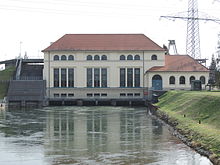 Water Management System in Meitingen | |
| Location | Germany |
| Criteria | Cultural: (ii), (iv) |
| Reference | 1580 |
| Inscription | 2019 (43rd Session) |
| Area | 112.83 ha (278.8 acres) |
| Buffer zone | 3,204.23 ha (7,917.8 acres) |
Water Management System
The water systems of Augsburg have been the site of innovations in hydraulic engineering for centuries.[29] Augsburg was built on top of an aquifer fed by the Lech and Wertach rivers, which provided purified groundwater that ran through the city through springs and streams.[30] The canals channeling this water through the city were first mentioned in 1276, and by 1416, waterworks, pumps, and water towers were added to effectively distribute this water.[30] In 1545, Augsburg was one of the first European towns to separate drinking water from water used for industry, effectively preventing water-borne diseases.[8] The pumps and waterwheels also generated power for fountains and food processing, such as a 17th century butcher's hall that still stands today.[30] In the 19th and 20th centuries, hydroelectic power plants were also installed. These power plants were some of the first in the world to generate electricity from water, and they are still in use today.[30]
On 6 July 2019, the Water Management System of Augsburg was designated as a UNESCO World Heritage Site.[31]
Urban legends


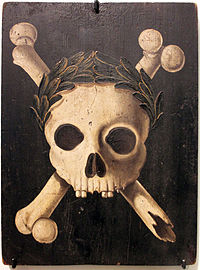
Goddess Cisa and the Stadtpir
The pagan goddess Cisa has been linked to the civic emblem of Augsburg, known as Stadtpir. Cisa and the Stadtpir came to represent the prosperity of the city. The Stadtpir was stamped on cloth that was approved by the town cloth inspector. Metalworks produced in the city were also stamped with the Stadtpir. The Stadtpir adorns the 17th century town hall.[32]
The Stoinerne Ma
The "Stoinerne Ma" ("Stony Man") is a life-size stone figure on the eastern Augsburg city wall in the area of the so-called "Sweden staircase", which is located in the immediate vicinity of the Galluskirche and St. Stephan convent (on the outside of the city wall). It is probably a one-armed baker with a loaf of bread and a shield. In the area of the feet there is a helically twisted pedestal.
According to the legend, it is the baker "Konrad Hackher" who, during a long siege of the city, baked bread from sawdust and threw it into the ditch clearly visible for the besiegers over the city wall. The impression that Augsburg would still have so much bread that one could throw it over the wall is said to have demoralized the besiegers so much that they fired at him with a crossbow out of anger. A hit struck off his arm, and soon afterwards the siege was broken off. Historically, the event belongs to the Thirty Years' War, more precisely to the siege of Augsburg during the years 1634/35, when Catholic Bavarian troops under Field Marshal von Wahl wanted to recapture the city occupied by the Protestant Swedes. The baker's deed is not reliably proven.
The statue is often visited by walkers strolling along the city wall. As it is said to be a fortunate thing to touch the stone figure's iron nose. This custom is particularly popular with lovers.[citation needed]
Bei den sieben Kindeln
In the wall of the property Bei den Sieben Kindeln 3 ("At the seven infants 3") there is a recessed stone relief from the Roman period. Legend says that the commemorative plaque was commissioned by a Roman officer to commemorate the drowning of one of his children (therefore it is said to be "seven" children, although the plaque represents only six: the seventh child is drowned and lies in the coffin). According to current knowledge, the plate once formed the long side of a Sarcophagus.[citation needed]
Lazarethe plague houses
The city of Augsburg had two civic plague houses. The two civic plague houses, called Lazarethe, were established when the black death first appeared in Augsburg in 1349. Thereafter they were opened whenever a plague epidemic occurred in the city. As soon as a medical practitioner, such as a barber surgeon, diagnosed the plague the patients were transferred to the plague houses by order of the city council. The transfer to the plague houses was publicly announced, so as to prevent panic and the breakdown of economic life. In the second half of the 18th century, the plague houses were used to treat other diseases, such as smallpox and scurvy.[33]
Incorporations
| Year | Municipality | Area |
|---|---|---|
| 1 July 1910 | Meringerau | 9.5 km2 |
| 1 January 1911 | Pfersee | 3.5 km2 |
| 1 January 1911 | Oberhausen | 8.6 km2 |
| 1 January 1913 | Lechhausen | 27.9 km2 |
| 1 January 1913 | Hochzoll | 4.4 km2 |
| 1 April 1916 | Kriegshaber | 59 km2 |
| 1 July 1972 | Göggingen | |
| 1 July 1972 | Haunstetten | |
| 1 July 1972 | Inningen |
Population
Historical development
| Year | Pop. | ±% |
|---|---|---|
| 1635 | 16,432 | — |
| 1645 | 19,960 | +21.5% |
| 1806 | 26,200 | +31.3% |
| 1830 | 29,019 | +10.8% |
| 1871 | 51,220 | +76.5% |
| 1890 | 75,629 | +47.7% |
| 1900 | 89,109 | +17.8% |
| 1910 | 102,487 | +15.0% |
| 1916 | 146,226 | +42.7% |
| 1925 | 165,522 | +13.2% |
| 1933 | 176,575 | +6.7% |
| 1939 | 185,369 | +5.0% |
| 1950 | 185,183 | −0.1% |
| 1961 | 208,659 | +12.7% |
| 1970 | 211,566 | +1.4% |
| 1975 | 252,000 | +19.1% |
| 1980 | 246,600 | −2.1% |
| 1985 | 244,200 | −1.0% |
| 1990 | 256,877 | +5.2% |
| 1995 | 259,699 | +1.1% |
| 2000 | 254,982 | −1.8% |
| 2005 | 262,676 | +3.0% |
| 2010 | 264,708 | +0.8% |
| 2015 | 281,111 | +6.2% |
| 2019 | 296,582 | +5.5% |
| Largest groups of foreign residents[34] | |
| Nationality | Population (31 December 2017) |
|---|---|
| 11,701 | |
| 7,242 | |
| 4,280 | |
| 4,123 | |
| 2,581 | |
| 2,392 | |
| 2,369 | |
| 2,129 | |
| 1,907 | |
| 1,823 | |
| 1,746 | |
| 1,650 | |
| 1,639 | |
| 1,512 | |
| 1,312 | |
| 1,256 | |
| Total | 64,627 |
Twin towns – sister cities
Augsburg is twinned with:[35]
 Inverness, Scotland, UK (1956)
Inverness, Scotland, UK (1956)
Transport
Roads
The main road link is autobahn A 8 between Munich and Stuttgart.
Public transport
Public transport is very well catered for. It is controlled by the Augsburger Verkehrs- und Tarifverbund (Augsburg transport and tariff association, AVV) extended over central Swabia. There are seven rail Regionalbahn lines, five tram lines, 27 city bus lines and six night bus lines, as well as several taxi companies.
The Augsburg tramway network is now 35.5 km-long after the opening of new lines to the university in 1996, the northern city boundary in 2001 and to the Klinikum Augsburg (Augsburg hospital) in 2002. Tram line 6, which runs 5.2 km from Friedberg West to Hauptbahnhof (Central Station), opened in December 2010.[36]
Intercity bus
There is one station for intercity bus services in Augsburg: Augsburg Nord, located in the north of the city.[37]
Railway

Augsburg has seven stations, the Central Station (Hauptbahnhof), Hochzoll, Oberhausen, Haunstetterstraße, Morellstraße, Messe and Inningen. The Central Station, built from 1843 to 1846, is Germany's oldest main station in a large city still providing services in the original building. It is currently being modernized and an underground tram station is built underneath it. Hauptbahnhof is on the Munich–Augsburg and Ulm–Augsburg lines and is connected by ICE and IC services to Munich, Berlin, Dortmund, Frankfurt, Hamburg and Stuttgart. As of December 2007, the French TGV connected Augsburg with a direct High Speed Connection to Paris. In addition EC and night train services connect to Amsterdam, Paris and Vienna and connections will be substantially improved by the creation of the planned Magistrale for Europe.
The AVV operates seven Regionalbahn lines from the main station to:
- Mammendorf
- Schmiechen (direction to Ammersee)
- Aichach/Radersdorf
- Meitingen/Donauwörth
- Dinkelscherben
- Schwabmünchen
- Klosterlechfeld
Starting in 2008, the regional services are planned to be altered to S-Bahn frequencies and developed long term as integrated into the Augsburg S-Bahn.
Air transport
Until 2005 Augsburg was served by nearby Augsburg Airport (AGB). In that year all air passenger transport was relocated to Munich Airport. Since then, the airport is used almost entirely by business airplanes.[38]
Economy


Augsburg is a vibrant industrial city. Many global market leaders namely MAN, EADS or KUKA produce high technology products like printing systems, large diesel engines, industrial robots or components for the Airbus A380 and the Ariane carrier rocket. After Munich, Augsburg is considered the high-tech centre for Information and Communication in Bavaria and takes advantage of its lower operating costs, yet close proximity to Munich and potential customers. In 2018 the Bavarian State Government recognized this fact and promoted Augsburg to Metropole.[39]
Major companies
- Boewe Systec[40]
- Faurecia
- Fujitsu Technology Solutions
- KUKA Robotics / Systems
- MAN (Maschinenfabrik Augsburg-Nürnberg)
- manroland
- MT-Aerospace (former MAN Technologie)
- NCR
- Osram
- Premium AEROTEC
- RENK AG (offshoot of MAN SE)
- Siemens
- UPM-Kymmene (former Haindl)
- WashTec (former Kleindienst)
- Synlab Group
- Cancom
- Check24
- Amazon
- Patrizia Immobilien
Education
Augsburg is home to the following universities and colleges:
- University of Augsburg, founded in 1970[41]
- Hochschule Augsburg (University of Applied Sciences, formerly Fachhochschule Augsburg)
Media
The local newspaper is the Augsburger Allgemeine first published in 1807.[citation needed]
Notable people
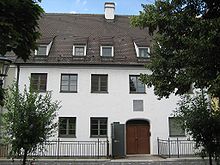
- Saint Afra, died 304
- Simpert, died 807
- Saint Ulrich (c. 890–973)
- Saint Wolfhard (1070–1127)
- Jakob Fugger the Elder (1398–1469)
- Erhard Ratdolt (1442–1528), Printer, famous for having produced the first known printers type specimen book
- Jakob Fugger (1459–1525), Noted banker and financial broker. An area within the city, called the Fuggerei was set aside for the poor and needy. Founded in 1519
- Hans Holbein the Elder (1460–1524), a pioneer in the transformation of German art from the Gothic to the Renaissance style
- Hans Holbein the Younger (1497–1543), portrait and religious painter
- Matthäus Schwarz (1497–c. 1574), accountant and author
- Paulus Hector Mair (1517–1579), martial artist
- Elias Holl (1573–1646), architect
- Philipp Hainhofer (1578–1647), merchant, banker, diplomat and art collector
- Julius Schiller (1580–1627), lawyer and astronomer
- Johann Georg Wirsung (1589–1643), anatomist
- Andreas Christoph Graf (1701–1776), German teacher, author and poet
- Johann Jakob Haid (1704–1767), engraver
- Leopold Mozart (1719–1787), violinist-composer and father of Wolfgang Amadeus Mozart
- Christoph Christian Sturm (1740–1786), preacher and author
- Eduard Bayer (1822–1908), composer and classical guitarist
- Rudolf Diesel (1858–1913), inventor of the diesel engine
- Albert Rehm (1871–1949), philologist who first understood the significance of the Antikythera mechanism
- Hans von Euler-Chelpin (1873–1964), co-recipient of 1929 Nobel Prize in Chemistry
- Karl Haberstock (1878–1956), Art dealer to the Nazis
- Artur Lauinger (1879–1961), German journalist
- Julius Streicher (1885–1946), prominent Nazi prior to World War II, founder and publisher of anti-Semitic Der Stürmer newspaper, executed for war crimes
- Julius Schaxel (1887–1943), biologist
- Hans Loritz (1895–1946), Nazi SS concentration camp commandant
- Bertolt Brecht (1898–1956), writer and theater director
- August Schmidhuber (1901–1947), Nazi SS officer executed for war crimes
- Wilhelm Gerstenmeier (1908–1944), SS concentration camp officer executed for war crimes
- Josef Priller (1915–1961), Luftwaffe ace
- Mietek Pemper (1920–2011), Polish-born Jew compiled and typed Oskar Schindler's list, which saved 1,200 Jewish prisoners from the Holocaust.[42][43]
- Günther Schneider-Siemssen (1926–2015), scenic designer
- Werner Haas (1927–1956), Grand Prix motorcycle road racer
- Ulrich Biesinger (1933–2011), former German footballer, part of the team that won the 1954 FIFA World Cup
- Helmut Haller (1939–2012), footballer who represented West Germany at three World Cups
- Hans Henning Atrott (born 1944), German author and theorist
- Wolf Blitzer (born 1948), American journalist and CNN reporter
- Bernhard Langer (born 1957), professional golfer
- Günther K.H. Zupanc (born 1958), neurobiologist, researcher, university teacher, book author, journal editor, and educational reformer
- Bernd Schuster (born 1959), football coach and former player
- Armin Veh (born 1961), football coach
- Sheryl Lee (born 1967), actress, poet, and activist
- Alexander Wesselsky (born 1968), lead singer of the German band Eisbrecher
- Florian Hecker (born 1975), experimental electronic music composer
- Marisa Olson (born 1977), artist
- Benny Greb (born 1980), solo drum artist
- Andreas Bourani (born 1983), singer-songwriter
- Philipp Kohlschreiber (born 1983), tennis player
- Bianca Voitek (born 1985), female bodybuilder
- Maximilian Hornung (born 1986), cellist
- Stefan Bradl (born 1989), motorcycle racer
- Johnny Cecotto Jr. (born 1989), racing driver
- Nico Sturm (born 1995), ice hockey player
Sports

FC Augsburg is a football team based in Augsburg and plays in the WWK ARENA to the south of the city centre. FC Augsburg secured promotion to Bundesliga in 2011 and have remained there ever since, qualifying for the Europa League for the first time in 2015 and securing mid-table finishes across the last few seasons. The club, nicknamed the Fuggerstädter or simply as FCA, reached the last 32 in the 2015-16 Europa League with a 1-0 aggregate defeat to Liverpool. The WWK ARENA, nicknamed the "Anfield of the B17 Highway" following the Liverpool UEL match, opened in July 2009 and also hosted games of the 2011 FIFA Women's World Cup. The 30,660 capacity arena is easily accessible from the city centre or the adjacent B17 dual carriageway.
The city is home to a DEL (first-division) ice hockey team, the Augsburger Panther. The original club, AEV, was formed in 1878, the oldest German ice sport club and regularly draws around 4000 spectators, quite reasonable for German ice hockey. Home games are played at the Curt Frenzel Stadion: a recently rebuilt (2012–2013) indoor rink and modern stadium and the club reached the 2018/19 DEL semi finals, eventually losing in the winner-takes-all game 7 to EHC Red Bull München (4-3 series defeat). Consequently, the Panthers qualified for the Champions Hockey League. Augsburg is also home to one of the most traditional German Baseball clubs, the Augsburg Gators and 2 American Football Clubs, the Raptors and Augsburg Storm, and in nearby Königsbrunn there's the Königsbrunn Ants.
For the 1972 Olympic Games in Munich, a Lech dam protective diversionary canal for river ice was converted into the world's first artificial whitewater slalom course: the Eiskanal and remains a world-class venue for whitewater competition and served as prototype for two dozen similar foreign courses.
Local city nicknames
While commonly called Fuggerstadt (Fuggers' city) due to the Fuggers residing there, within Swabia it is also often referred to as Datschiburg: which originated sometime in the 19th century refers to Augsburg's favorite sweet: the Datschi made from fruit, preferably prunes, and thin cake dough.[44] The Datschiburger Kickers charity football team (founded in 1965) reflects this in its choice of team name.[45][46]
Among younger people, the city is commonly called "Aux" for short. [citation needed]
See also
- Augsburg University, a private Lutheran College in Minneapolis, Minnesota (USA) that takes its name from the Augsburg Confession
- League of Augsburg
- List of civic divisions of Augsburg
- List of mayors of Augsburg
- Synods of Augsburg
Notes
- Liste der Oberbürgermeister in den kreisfreien Städten, Bayerisches Landesamt für Statistik, accessed 19 July 2021.
- "Tabellenblatt "Daten 2", Statistischer Bericht A1200C 202041 Einwohnerzahlen der Gemeinden, Kreise und Regierungsbezirke". Bayerisches Landesamt für Statistik (in German). June 2021.
- "Augsburg". Lexico UK English Dictionary. Oxford University Press. Archived from the original on 11 March 2020.
- "Augsburg". Merriam-Webster Dictionary. Retrieved 12 August 2019.
- "Und-wieder-5000-Menschen-mehr-Augsburg-waechst-und-waechst". www.augsburger-allgemeine.de. 17 February 2015.
- Behringer 2011, p. 350.
- ""Great honor": Augsburg water management system recognized as a World Heritage". tellerreport.com. 6 July 2019.
- "Water Management System of Augsburg". UNESCO World Heritage Centre. United Nations Educational, Scientific, and Cultural Organization. Retrieved 1 October 2022.
- John G. Kelcey; Norbert Müller (7 June 2011). Plants and Habitats of European Cities. Springer Science & Business Media. ISBN 978-0-387-89684-7.
- Jecmen, Gregory; Spira, Freyda (2012). Imperial Augsburg: Renaissance Prints and Drawings, 1475-1540. National Gallery of Art (U.S.). p. 25. ISBN 9781848221222.
- Tore Janson (2007). A Natural History of Latin. OUP Oxford. p. 169. ISBN 9780191622656.
- Jecmen, Gregory; Spira, Freyda (2012). Imperial Augsburg: Renaissance Prints and Drawings, 1475-1540. National Gallery of Art (U.S.). p. 25. ISBN 9781848221222.
- "After Almost 500 Years, the World's Oldest Social Housing Complex is Still Going Strong".
- Luther, Martin (15 September 2015). On Commerce and Usury (1524). Anthem Press. p. 146. ISBN 978-1-78308-387-9. Retrieved 7 August 2022.
- studio, Istituto internazionale di storia economica F. Datini Settimana di (1999). Poteri economici e poteri politici secc. XIII-XVIII: atti della "trentesima Settimana di studi," 27 aprile-1 maggio 1998. Le Monnier. p. 56. ISBN 978-88-00-72230-8. Retrieved 7 August 2022.
- Tlusty, B. Ann (2012). Augsburg During the Reformation Era: An Anthology of Sources. Hackett Publishing Company. pp. xviii. ISBN 9781603849203.
- "Leopold Mozart: Biography & History". allmusic.com. Retrieved 24 February 2017.
- Metzig, Gregor (21 November 2016). Kommunikation und Konfrontation: Diplomatie und Gesandtschaftswesen Kaiser Maximilians I. (1486–1519) (in German). Walter de Gruyter GmbH & Co KG. pp. 98, 99. ISBN 978-3-11-045673-8. Retrieved 7 February 2022.
- Meinel, Christoph; Sack, Harald (2014). Digital Communication: Communication, Multimedia, Security. Springer Science & Business Media. p. 31. ISBN 9783642543319. Archived from the original on 26 September 2021. Retrieved 20 September 2021.
- Behringer, Wolfgang (2011). "Core and Periphery: The Holy Roman Empire as a Communication(s) Universe". The Holy Roman Empire, 1495-1806 (PDF). Oxford: Oxford University Press. pp. 347–358. ISBN 9780199602971. Archived (PDF) from the original on 9 October 2022. Retrieved 7 August 2022.
- Behringer, Wolfgang (2003). Witchcraft Persecutions in Bavaria: Popular Magic, Religious Zealotry and Reason of State in Early Modern Europe. Cambridge University Press. p. 95. ISBN 9780521525107.
- Hays, J. N. (2005). Epidemics and pandemics: their impacts on human history. ABC-CLIO. p. 98]. ISBN 1851096582.
- Prak, Maarten; Epstein, S. R. (2008). Guilds, Innovation and the European Economy, 1400–1800. Cambridge University Press. p. 123. ISBN 9781139471077.
- Wolfgang Sofsky, William Templer, The Order of Terror: The Concentration Camp: Princeton University Press: 1999, ISBN 0-691-00685-7, page 183
- Edward Victor. Alphabetical List of Camps, Subcamps and Other Camps. "List of Camps". Archived from the original on 16 December 2010. Retrieved 25 July 2008.
- "Campaign Diary February 1944". Royal Air Force Bomber Command 60th Anniversary. UK Crown. Archived from the original on 6 July 2007. Retrieved 7 December 2014.
- ePaper 14. January 2014: Results of the Bundestagswahl 2014 in Augsburg (PDF; 12,1 MB)
- "Germany Bavaria Museums and Galleries Römisches Museum Augsburg". bavaria.by. Archived from the original on 25 February 2017. Retrieved 24 February 2017.
- James Douet (2018). "The Water Industry as World Heritage" (PDF). The International Committee for the Conservation of the Industrial Heritage (TICCIH). p. 32. Archived (PDF) from the original on 9 October 2022.
- Water Management System of Augsberg (Germany), No. 1580 (Report). ICOMOS. 13 March 2019. Retrieved 1 October 2022.
- "Seven more cultural sites added to UNESCO's World Heritage List". UNESCO. 6 July 2019.
- Tarbin, Stephanie; Broomhall, Susan (2008). Women, Identities and Communities in Early Modern Europe. Ashgate Publishing Company. p. 122. ISBN 9780754661849.
- Tlusty, Ann B.; Häberlein, Mark (2020). A Companion to Late Medieval and Early Modern Augsburg. BRILL. p. 53. ISBN 9789004416055.
- "Strukturdaten nach Stadtbezirk" (PDF). Archived from the original (PDF) on 27 April 2019. Retrieved 25 June 2018.
- "Augsburgs Partnerstädte – Freundschaften und Begegnungen auf drei Kontinenten". augsburg.de (in German). Augsburg. Retrieved 4 November 2020.
- "Railway Gazette: Urban rail news in brief". Retrieved 2 January 2011.
- "Augsburg: Stations". Travelinho.com. Archived from the original on 4 August 2020. Retrieved 2 December 2017.
- "Augsburg Airport (EDMA)". flughafen-augsburg.de. Retrieved 24 February 2017.
- "Verordnung zur Änderung der Verordnung über das Landesentwicklungsprogramm Bayern" (PDF). Bayerisches Staatsministerium der Finanzen, für Landesentwicklung und Heimat. 21 February 2018. Archived from the original (PDF) on 18 July 2018. Retrieved 18 July 2018.
- "BÖWE SYSTEC GmbH | Kuvertiersysteme, Kartenversandsysteme, Sortieranlagen, Lesetechnologie und Software". boewe-systec.com. Retrieved 24 February 2017.
- "Universität Augsburg". uni-augsburg.de. Retrieved 24 February 2017.
- "Oskar Schindler's collaborator, Mietek Pemper, has died". Agence France-Presse. The Gazette (Montreal). 15 June 2011. Retrieved 26 June 2011.[permanent dead link]
- Martin, Douglas (18 June 2011). "Mietek Pemper, 91, Camp Inmate Who Compiled Schindler's List". The New York Times. Archived from the original on 23 June 2011. Retrieved 26 June 2011.
- Augsburger Stadtlexikon – Datschiburg Archived 19 July 2011 at the Wayback Machine (in German) accessed: 18 November 2008
- Datschiburger Kickers website Archived 6 October 2009 at the Wayback Machine accessed: 18 November 2008
- Augsburger Stadtlexikon – Datschiburger Kickers (in German) accessed: 18 November 2008
References
- Die Chroniken der schwäbischen Städte, Augsburg, (Leipzig, 1865–1896).
- Werner, Geschichte der Stadt Augsburg, (Augsburg, 1900).
- Lewis, "The Roman Antiquities of Augsburg and Ratisbon", in volume xlviii, Archæological Journal, (London, 1891).
- Michael Schulze, Augsburg in one day. A city tour Lehmstedt Verlag, Leipzig 2015, ISBN 978-3957970176.
Bibliography
External links
- Stadt Augsburg Official site (English version)
- Augsburg Tourism Official tourism portal for Augsburg region
- (in German) Augsburg City Plan
- (in German) District of Augsburg
- Hydraulic Engineering and Hydropower, Drinking Water and Decorative Fountains in Augsburg Archived 6 July 2019 at the Wayback Machine
На других языках
[de] Augsburg
Augsburg (im Dialekt Augschburg,[3] lateinisch Augusta Vindelicum und Augusta Vindelicorum) ist eine kreisfreie Großstadt im Südwesten Bayerns und eine der drei bayerischen Metropolen.[4] Sie ist Universitätsstadt und Sitz der Regierung des Bezirks Schwaben sowie des Landratsamtes des die Stadt im Westen umgebenden Landkreises Augsburg.- [en] Augsburg
[ru] Аугсбург
А́угсбург (нем. Augsburg, бав. Augschburg) — университетский город на юго-западе Свободного государства Бавария, столица Швабии.Другой контент может иметь иную лицензию. Перед использованием материалов сайта WikiSort.org внимательно изучите правила лицензирования конкретных элементов наполнения сайта.
WikiSort.org - проект по пересортировке и дополнению контента Википедии

